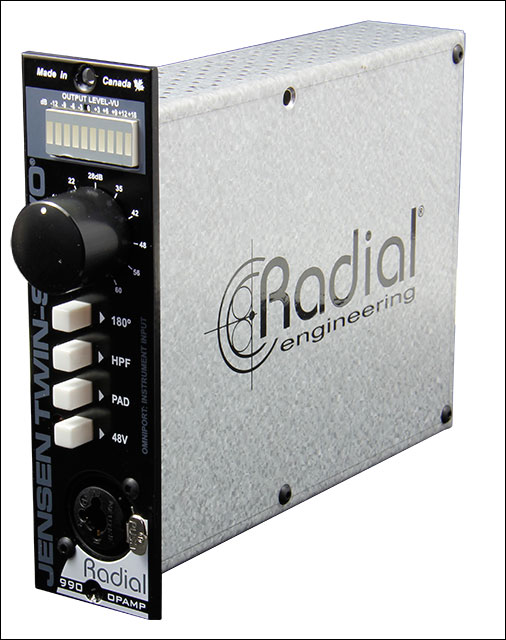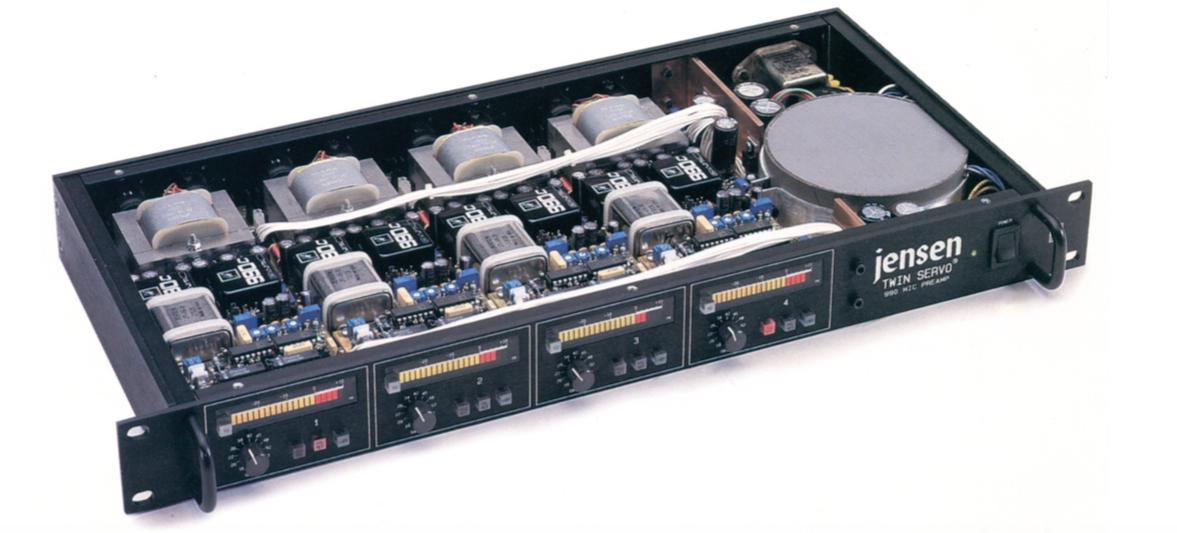New Gear Review: Radial Twin Servo 500 Mic Preamp

The new Twin Servo 500 from Radial Engineering brings the astonishingly hi-fi performance of the Jensen Twin Servo to a compact 500-series package.
Those of you lucky enough to know what a Jensen Twin Servo 990 or John Hardy preamp sounds like will probably be very exited to hear about the new Twin Servo 500 series microphone preamp from Radial.
My first encounter with the original Jensen Twin Servo 990 was back at RPM Studios in NYC when I was just starting out. The Jensen was always the first choice when recording very quiet sound sources or anything that required a lot of gain without distortion.
Although I know it was the go-to tool for so many great engineers in these situations, I never understood why it performed so well with these kind of sources until recently, when I had the opportunity to test drive a Twin Servo from Radial.
In Use
The basic theory behind the original Jensen 990 Twin Servo is that there are two Op Amps that share the work of amplification. This means that each Op Amp is “working” half as much, and therefore, results in a lower noise floor and half the distortion. I learned that Radial is faithfully reproducing the Twin Servo preamp in the 500 series package. Radial Engineering acquired Jensen in 2014, so this is not just an attempt at replicating or reverse-engineering the original design—it is the original design, updated and ported over to a new, compact format.
I figured the only real way to test this guy was to A/B it with an original. So, using a Radial Pro MS2 mic splitter, I sent the signal from a Neuman U87 to both a Jensen 990 Twin Servo and the new Radial Jensen Twin Servo. I recorded everything from vocals, to cymbals, to snares, to a glock (enspiel). I have included samples of these here so you can hear them for yourself.
The difference was actually a little bit surprising. I was not expecting too much of a difference, but as you can hear, there is. At the same settings, the new Radial Jensen Twin Servo seemed crisper, sharper clearer and louder to my ear.
To make things more fair, I have level-matched the examples here by normalizing the audio files to make the subtle difference in tone apparent I am going to attribute this difference to the fact that the Jensen 990 Twin Servo I had access to was about thirty years old, and could be in need of service. Who knows if an off-the-shelf Jensen might have sounded more identical? Either way, I preferred the accuracy of the new Radial Twin Servo.
Click here and fire up some good headphones or speakers if you’d like to download the full resolution WAV files and hear the subtle difference for yourself.
Features
One of the improvements Radial has made over the original is the size of the gain pot. While this is a small step up, it is worth noting.
It is much nicer to grab a big knob (double entendre intended / #AudioNerdHumor). Another merit of this reincarnation is putting it into the 500 series format—a great idea.
Previously, the Jensen 990 twin servo had its own proprietary 1RU rack and power supply, topping out at four slots. Now, depending on what 500 series chassis you have, you can have half a console’s worth of them.
The last positive worth mentioning is that, like all Radial products, this thing seems to be built like a tank! I remember my first time picking up a Radial Pro DI and being comforted by the shear weight of the thing.
The only downside that I can see thus far is the price tag. Not that it’s unreasonable for the product, it’s just that at $999 it seems to be on par with the cost of a vintage Jensen 990 Twin Servo, which as I have found out, can be worse than this updated version.
I am afraid that people will play the vintage gear “Price Is Right” game show; and buy a piece of gear for the name, not for the way it sounds. If Radial can find a way to drop the price by just $100 or $200, I think they would have as many people hooked as Frank Lucas did with his Blue Magic.
Needless to say, I am thrilled with what Radial has done here. Although 99% of the time I will reach for a Neve or tube preamp, there are those occasions, namely on strings, soft vocals, or any kind of room mic, when I want to be able to crank up the gain and not hear caps or op amps hissing away.
Usually I’m at the mercy of whatever the studio is equipped with, and the assistant engineer will point to something like an API, which is fine (and I’ll probably get shot for saying this), but it’s not really as good as a Twin Servo in terms of headroom. If you’ve used them, you know, that signature crackle when you hit an API too hard.
I think what I am trying to say, is that every studio should own at least a pair of these. They are an indispensable piece of gear, and a perfect compliment to a rack full of vibey Neve, Telefunken, and Helios pres. I’m glad to see that Radial has taken the helm on recreating this one. They’ve knocked it out of the park—again.









Robert Parsons
September 30, 2016 at 8:47 am (8 years ago)Hi Nic,
I enjoyed the review; it’s nice to finally get to read a head-to-head with standalone Twin Servo hardware vs the 500 Radial Twin Servo module.
I’m quite curious about something and I’m hoping you can help to clarify it. We have some big, high-end voiceover projects coming up with male baritone voice talent who have long used the John Hardy Twin Servo 990 for their work. Because of portability requirements on the upcoming projects, we’d like to explore the 500 series/Radial module but don’t have an opportunity, because of location, to do our own head-to-head.
The greatest appeal of the Hardy Twin Servo in the voiceover world has long been its clean/neutral-but-not-sterile qualities, much like the Hardy M1 but, I think most would say, his 990 is just a little richer and better. In our voiceover work, the clients want the most accurate representation of the talents’ voices so they can do their own processing in their own studios, so the neutral-but-not-sterile M1 and Twin Servo have been go-to preamps for many in the voiceover world for a long time.
I suppose I’d have felt better about the Radial Twin Servo if you’d said they were both 100% exactly the same :), since that would have erased any doubt about the head to head qualities we’re after.
Could I therefore ask you to give me your own expanded opinion of how the transparency / neutrality of the Radial product seems to compare in your own studio to that of the standalone preamp…with regard to the needs of the voiceover talent in particular (as much like the Hardy Twin Servo as possible, neutral, etc.)? We’ve had some trouble opening the audio results of your test and may find ourselves in a remote location without internet for a bit so I’m hoping you don’t mind taking the time to give me a slightly expanded description of how you feel the nice subtle neutral tone of the Hardy Twin Servo compares with the Radial module for our voiceover needs.
Thanks very much, Nic; I do appreciate your input.
Regards!
I enjoyed the review; it’s nice to finally be able to hear a head-to-head with some standalone hardware vs the 500 Radial Twin Servo module.
I’m quite curious about something and I’m hoping you can help to clarify it. We have some big, high-end voiceover projects coming up with male baritone voice talent who have long used the John Hardy Twin Servo 990 for their work. Because of portability requirements on the upcoming projects, we’d like to explore the 500 series/Radial module but don’t have an opportunity because of location to do our own head-to-head.
The greatest appeal of the Hardy Twin Servo has been its clean/neutral-but-not-sterile qualities, much like the M1 but, I think most would say, just a little richer and better. In our voiceover work, the clients want the most accurate representation of the talents’ voices so they can do their own processing in their own studios, so the neutral-but-not-sterile M1 and Twin Servo have been go-to preamps for many in the voiceover world for a long time.
I suppose I’d have felt better about the Radial Twin Servo if you’d said they were both 100% exactly the same :), since that would have erased any doubt about the head to head qualities we’re after.
Could I therefore ask you to give me your own opinion of how the transparency / neutrality of the Radial product seems to compare in your own studio to that of the standalone preamp? We’ve had some trouble opening the results of your test and may find ourselves in a remote location without internet for a bit so I’m hoping you don’t mind taking the time to give me a slightly expanded description of how you feel the nice subtle neutral tone of the Hardy Twin Servo compares with the Radial module.
Thanks very much, Nic; I do appreciate your input.
Regards!